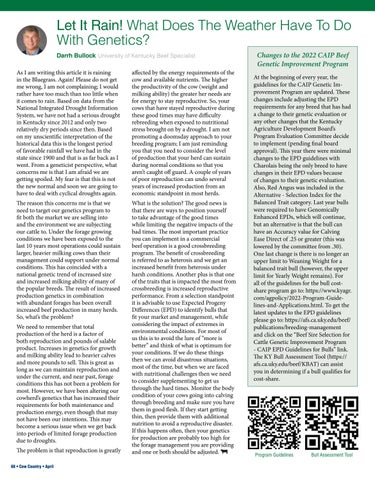Let It Rain! What Does The Weather Have To Do With Genetics? Darrh Bullock University of Kentucky Beef Specialist As I am writing this article it is raining in the Bluegrass. Again! Please do not get me wrong, I am not complaining; I would rather have too much than too little when it comes to rain. Based on data from the National Integrated Drought Information System, we have not had a serious drought in Kentucky since 2012 and only two relatively dry periods since then. Based on my unscientific interpretation of the historical data this is the longest period of favorable rainfall we have had in the state since 1900 and that is as far back as I went. From a geneticist perspective, what concerns me is that I am afraid we are getting spoiled. My fear is that this is not the new normal and soon we are going to have to deal with cyclical droughts again.
affected by the energy requirements of the cow and available nutrients. The higher the productivity of the cow (weight and milking ability) the greater her needs are for energy to stay reproductive. So, your cows that have stayed reproductive during these good times may have difficulty rebreeding when exposed to nutritional stress brought on by a drought. I am not promoting a doomsday approach to your breeding program; I am just reminding you that you need to consider the level of production that your herd can sustain during normal conditions so that you aren’t caught off guard. A couple of years of poor reproduction can undo several years of increased production from an economic standpoint in most herds.
The reason this concerns me is that we need to target our genetics program to fit both the market we are selling into and the environment we are subjecting our cattle to. Under the forage growing conditions we have been exposed to the last 10 years most operations could sustain larger, heavier milking cows than their management could support under normal conditions. This has coincided with a national genetic trend of increased size and increased milking ability of many of the popular breeds. The result of increased production genetics in combination with abundant forages has been overall increased beef production in many herds. So, what’s the problem?
What is the solution? The good news is that there are ways to position yourself to take advantage of the good times while limiting the negative impacts of the bad times. The most important practice you can implement in a commercial beef operation is a good crossbreeding program. The benefit of crossbreeding is referred to as heterosis and we get an increased benefit from heterosis under harsh conditions. Another plus is that one of the traits that is impacted the most from crossbreeding is increased reproductive performance. From a selection standpoint it is advisable to use Expected Progeny Differences (EPD) to identify bulls that fit your market and management, while considering the impact of extremes in environmental conditions. For most of us this is to avoid the lure of “more is better” and think of what is optimum for your conditions. If we do these things then we can avoid disastrous situations, most of the time, but when we are faced with nutritional challenges then we need to consider supplementing to get us through the hard times. Monitor the body condition of your cows going into calving through breeding and make sure you have them in good flesh. If they start getting thin, then provide them with additional nutrition to avoid a reproductive disaster. If this happens often, then your genetics for production are probably too high for the forage management you are providing and one or both should be adjusted.
We need to remember that total production of the herd is a factor of both reproduction and pounds of salable product. Increases in genetics for growth and milking ability lead to heavier calves and more pounds to sell. This is great as long as we can maintain reproduction and under the current, and near past, forage conditions this has not been a problem for most. However, we have been altering our cowherd’s genetics that has increased their requirements for both maintenance and production energy, even though that may not have been our intentions. This may become a serious issue when we get back into periods of limited forage production due to droughts. The problem is that reproduction is greatly 68 • Cow Country • April
Changes to the 2022 CAIP Beef Genetic Improvement Program At the beginning of every year, the guidelines for the CAIP Genetic Improvement Program are updated. These changes include adjusting the EPD requirements for any breed that has had a change to their genetic evaluation or any other changes that the Kentucky Agriculture Development Board’s Program Evaluation Committee decide to implement (pending final board approval). This year there were minimal changes to the EPD guidelines with Charolais being the only breed to have changes in their EPD values because of changes to their genetic evaluation. Also, Red Angus was included in the Alternative - Selection Index for the Balanced Trait category. Last year bulls were required to have Genomically Enhanced EPDs, which will continue, but an alternative is that the bull can have an Accuracy value for Calving Ease Direct of .25 or greater (this was lowered by the committee from .30). One last change is there is no longer an upper limit to Weaning Weight for a balanced trait bull (however, the upper limit for Yearly Weight remains). For all of the guidelines for the bull costshare program go to: https://www.kyagr. com/agpolicy/2022-Program-Guidelines-and-Applications.html. To get the latest updates to the EPD guidelines please go to: https://afs.ca.uky.edu/beef/ publications/breeding-management and click on the “Beef Sire Selection for Cattle Genetic Improvement Program - CAIP EPD Guidelines for Bulls” link. The KY Bull Assessment Tool (https:// afs.ca.uky.edu/beef/KBAT) can assist you in determining if a bull qualifies for cost-share.
Program Guidelines
Bull Assessment Tool

















